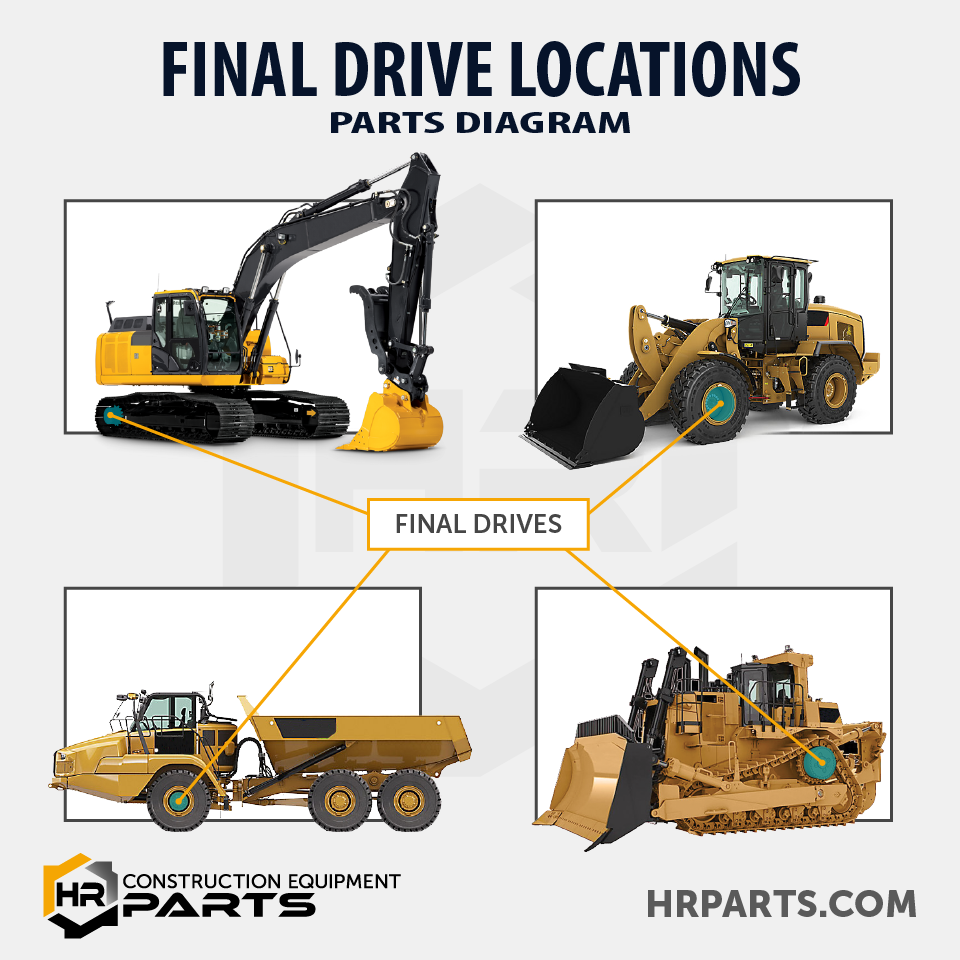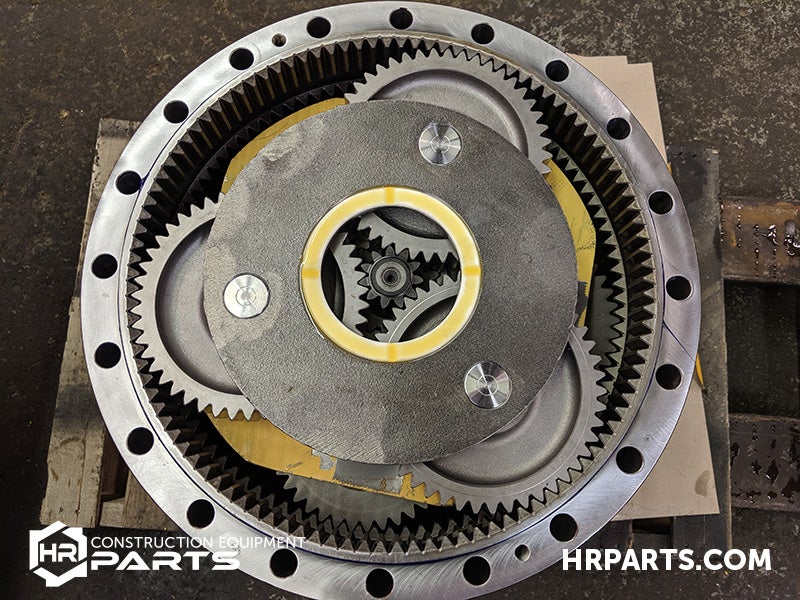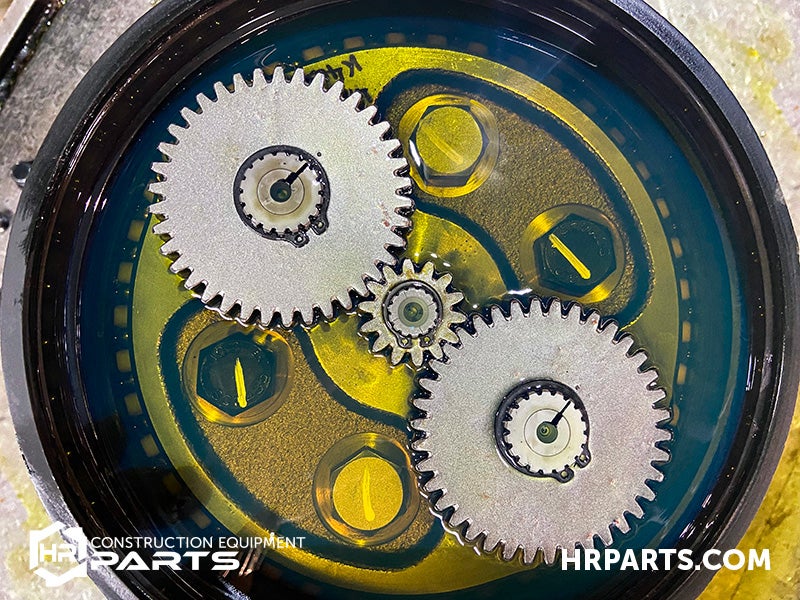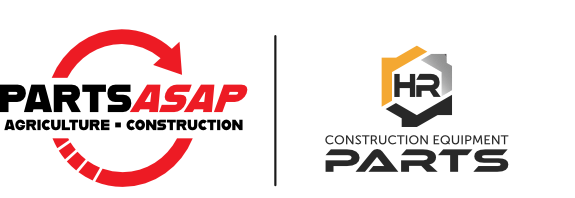
What is a Final Drive with Final Drive Diagram
At H&R, we’ve developed a reputation as experts in new aftermarket final drives and reconditioned final drives, but outside of the industry that expertise is often met with a quick follow-up, “Great and what’s a final drive?”
Whether you’re asking that question yourself or just looking for more information on final drives, we’ve written this quick final drive summary for web searchers like you. It’s simple and short (and there's an image gallery at the bottom), but hopefully it’ll help you out — which when it comes to final drives is kind of what we're all about.
What is a final drive in heavy construction equipment?
- On heavy construction equipment, final drives transfer power from the drive train to the tires or tracks using a system of gears designed to reduce speed and increase torque.
- If you visualize the great power trip force takes as it goes from engine to the movement of wheels or tracks, you’ll see it passes through a number of gears and shafts on it’s journey. The final drive is that last part in a machine’s powertrain system, and subsequently, the final component for increasing torque through gear reduction or changing the direction of power flow.
- Final drives exist across machine types, makes, and models and, though they often share many of the same basic concepts, final drives are implemented and designed in ways that are unique to their purpose, their machine type, and even the machine’s manufacturer.
What is the importance and purpose of a final drive?
- Torque is a measure of the amount of rotational force of an object and in large machinery it’s all (or at least mostly all) about torque. If you’ve ever used any kind of system of gears — even an old 10-speed bike — you already know that gears can quickly convert your power into speed or torque, and vice versa. That’s because the relationship between torque and speed is inversely proportional — one goes up and the other goes down.
- A final drive uses a set of planetary gears (or a bull-and-pinion gear system) to convert force into torque one last time and, in doing so, allows the shafts, bearings, and gears to deliver power without being under the constant strain of a high-torque system.
- Because of the high torque loads they routinely handle and their close connection to tires, tracks, or sprockets, final drives have to be designed to perform under intense circumstances and absorb feedback while they work.
- When you see a bulldozer clearing a small mountain down to flat land, you can thank the final drive for it’s important part in the process.
What is a planetary gear system?
- A planetary gear system (or epicyclic gear train) consists of a sun gear in the center surrounded by planet gears with a ring gear around the outside of the planet gears. The planetary gear system is named as such because of its analogy to the planets orbiting and circling the sun.
- Since multiple planet gears are used in the process, the torque capability of the system is greatly increased.
Where on a machine is a final drive located?
- A final drive on construction equipment machinery can be standalone or integrated into the axle housing and the position depends on the needs and duties of the machine. The workings and design of final drives often share similar aspects, but the shape, location, and many of the components of a final drive are specific to a machine.

What are the parts in final drives with planetary gears?
Final Drive Housing
The housing on a final drive is the container that will enclose the final drive components, keep them in a lubricated environment, and connect to the machine. Because of the immense forces happening inside the final drive, the housing must be constructed to stand up to both internal and external forces. In heavy construction equipment, the final drive housing can be incredibly large and heavy. Overhead cranes, forklifts, and other equipment are often needed to work on a final drive.
Planetary Gears
In final drives with planetary gears, there are often two sets of planetary gears — an inner planetary and an outer planetary — each composed of a set of three planet gears and held together by a carrier.
Sun Gear
At the center of planet gears is the sun gear. The sun gear is the component bringing force into the final drive to be transformed into high-torque output.
The Ring Gear
The ring gear sits around the planet gears. The planet gears, taking power from the sun gear, turn inside the ring gear as they transform the power into increased torque.
Ball Bearings
Ball bearings are a common component to machines of all types, purposes, and designs. Bearings are designed to allow specific movement while greatly reducing friction. In a ball bearing, balls are contained inside of bearing races. To ensure proper functionality bearings must be designed and crafted to meet exact specifications and standards. Bearings in a final drive must be well-oiled at all times to reduce fiction.
O-Rings and Seals
O-rings and seals are another common component in any mechanical system. In a final drive, the O-rings and seals are designed to keep all lubricant inside of the housing and to prevent outside elements from entering the housing. Both the loss of lubricant and the introduction of foreign matter into a final drive will lead to fast and detrimental degradation of the internal components.
While certainly not the final word on final drives, we hope you found this overview helpful and we appreciate you reading it today. If you’re interested in learning more about final drives, the next step is to watch an H&R parts specialist assemble a reconditioned final drive. Or if you're a picture person, keep scrolling to our final drive gallery.
Final Drive Image Gallery












